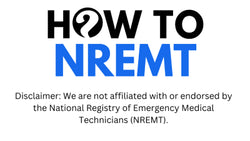“I spent hours studying, but the real exam felt nothing like my test bank.”
That’s the frustration many feel when generic questions disappoint. Real NREMT practice questions can be game‑changers. They build familiarity with exam structure, language, and thinking patterns. With so much on the line, only high‑quality prep works.
In this guide, we break down why it’s important to find credible sources for authentic NREMT practice questions and how to spot the high-quality questions.
Why Realistic Practice Matters
You can’t rely on rote memorization while preparing for the NREMT exam. It’s important to align your prep with the actual exam pattern. Here’s why it’s matters:
1. More accurate format
Authentic questions mirror the NREMT cognitive exam practice format—with technology enhanced items (TEIs), scenario‑based writing, and adaptive testing logic. Standard Q‑banks often skip these. Recognizing real exam patterns lowers test‑day anxiety.
2. Sharper clinical judgment
Good practice engages your mind, not just recall. You’ll learn to reason, compare options, and eliminate distractors. That’s how you build clinical judgment—the skill the NREMT really tests.
3. Targeted strengths & weaknesses
Realistic questions highlight your specific gaps. Did you miss airway‑management TEIs or scene‑size‑up items? Authentic practice zeroes in on issues so you can improve strategically.
4. Confidence boost
Familiarity with the structure, wording, and pacing reduces exam stress. Every successful attempt builds assurance, reinforcing the belief that NREMT test prep can, and does, work.

Where to Find High-Quality Practice Questions
Now that we have built upon the importance of practicing with authentic NREMT practice questions, let’s discover sources where you can find those questions.
1. Official NREMT Sample Items
The National Registry offers sample EMR, EMT, AEMT, and Paramedic questions. These show real exam structure, TEIs, and scoring style. Use them early to orient yourself.
2. Accredited Prep Programs
Choosing the best NREMT test prep means selecting providers using NREMT‑valid content. Look for programs that:
·Regularly update content after NREMT changes (e.g., April 2025 BLS test plan)
·Include TEI practice: drag‑and‑drop, multi‑select, build list
·Simulate adaptive timing and result flow
·Provide detailed explanations, not just answers
Programs with live tutors or forums help clarify the thought processes behind answers.
3. Peer‑Reviewed Question Banks
Some academic apps and university programs develop their own items. When written by EMS educators familiar with NREMT content objectives, these can be strong supplements. Cross‑check their alignment with NREMT domains and current exam content outlines.
4. Community QA Platforms
Reddit, EMT forums, and student groups sometimes share discussion‑style question drills. These can sharpen reasoning skills but may vary widely in quality. Use them to test problem‑solving, not content reliability.
Spotting Fake or Weak Questions
|
Red flag |
Why it fails |
|
Overly simplistic |
Rarely reflects clinical complexity |
|
Outdated topics |
Based on old domains like "Airway Flash" |
|
No rationale |
You learn more from explanations |
|
No TEI formats |
Missing interactive question types |
|
No alignment to exam plan |
Always check the current NREMT exam blueprint |
Avoid sources that feel like trivia quizzes. The NREMT practice questions you use should resemble what you’ll face, from answer choices to item length.
How to Vet Your Question Sources
1. Match the exam style – verify question tagging matches domains: Scene Size‑Up, Primary Assessment, Secondary Assessment, Patient Treatment & Transport, Operations.
2. Check recency – topics should match the April 7 2025 test structure.
3. Look for TEI coverage – confirm drag‑and‑drop, multi‑select, and list‑ordering items exist.
4. Review explanations – strong Q‑banks show why answers are right and wrong.
5. Simulate testing conditions – time limits, randomized order, and no back‑tracking reflect real test rules.
6. Review performance stats – reliability comes from consistent feedback over time.

Build a High‑Quality Practice Routine
While finding authentic practice questions is important, it’s only half the job. What sets you up for success is building a consistent schedule. Here’s how you can structure your NREMT test prep:
·Start broad – begin with sample items from NREMT and well‑vetted banks.
·Practice TEIs daily – even five TEIs per day builds familiarity.
·Review your mistakes – spending time understanding each error strengthens clinical reasoning.
·Mirror test timing – schedule 2‑hour timed sessions mimicking your exam slot.
·Assess progress – use performance reports to inform what to study next.
Why It Impacts Your Exam Readiness
Here’s how practicing through authentic platforms and having a structured routine makes you test-day ready:
·Reduces surprise – seeing real‑style items builds fluency.
·Strengthens decision flow – TEIs force layered thinking.
·Avoids wasted study – unaligned practice distracts your limited study time.
·Builds mental stamina – timed sessions prepare you for the endurance test format.
Other Tips to Complement Authentic Practice
1. Study with peers or paramedic tutoring support to refine clinical reasoning.
2. Join virtual NREMT prep class sessions to reinforce strategy.
3. Track your habits using study logs and adjust based on performance data (percentage correct, domain breakdowns).
4. Explore integrated flashcards tied to your question bank errors.
5. Use a NREMT cognitive exam practice plan with daily goals—e.g., 50 questions plus 10 TEIs per week.
Final Word
Mastering the NREMT isn’t about how many hours you study; it’s about what you study, and authentic, exam-style questions are the most efficient way to sharpen the exact skills being tested. Whether you're testing for the first time or retesting after a failed attempt, low-quality question banks waste time, weaken confidence, and often reinforce the wrong habits.
Using real NREMT practice questions prepares you for what actually shows up on test day:
·The language used in questions.
·The reasoning process behind clinical decisions.
·The latest TEI (Technology Enhanced Item) formats like drag-and-drop, multi-select, and sequencing.
·And the domains the NREMT cares about: not trivia, but real-time, patient-centered judgment.
Most importantly, using high-quality questions teaches you how to think like the test wants you to think, and that’s the biggest edge of all.
If you’re serious about finding the best NREMT test prep, whether you're an EMT or paramedic, focus on realism, structure, and feedback. Every question should either teach you something new or reinforce a winning habit.
And remember: confidence isn’t built in theory. It’s built in practice. The right kind.

Ready to Study Smarter? Boost Performance with How To NREMT
We built our platform for real‑style NREMT practice. You get:
2,000+ NREMT‑aligned questions
Interactive TEI practice and detailed explanations
Personalized performance metrics and domain feedback
Access to NREMT prep class drills and live Q&A
AI‑powered question coach to guide your thinking
Get test‑ready with us. Try NREMT practice questions that really matter.

